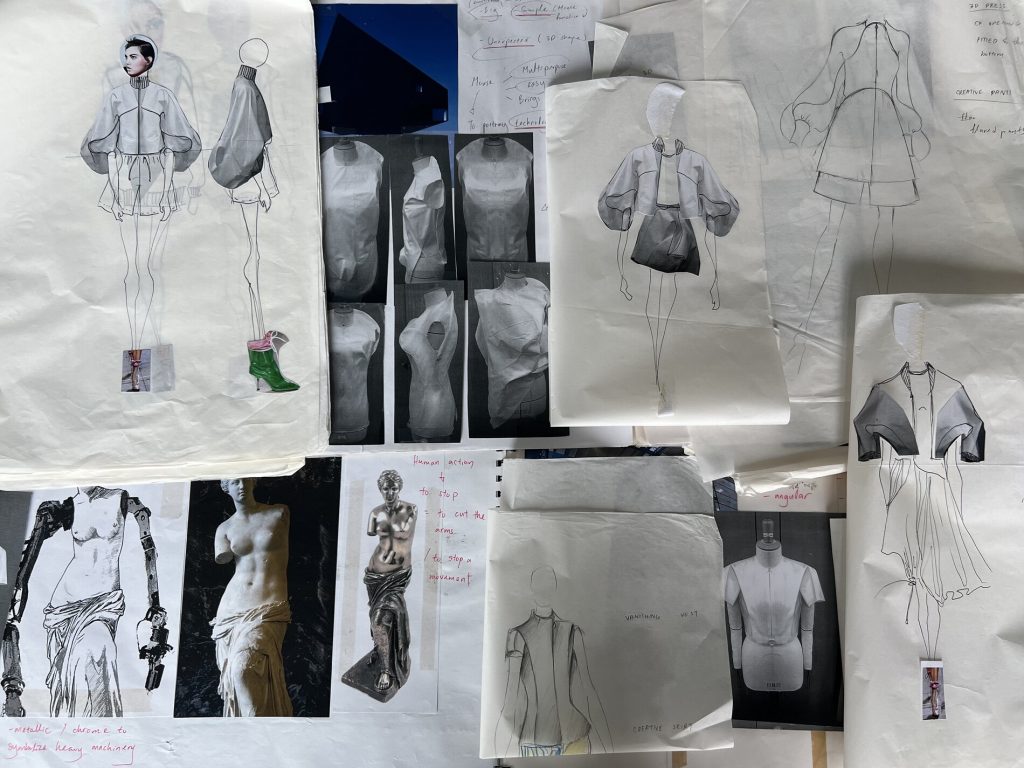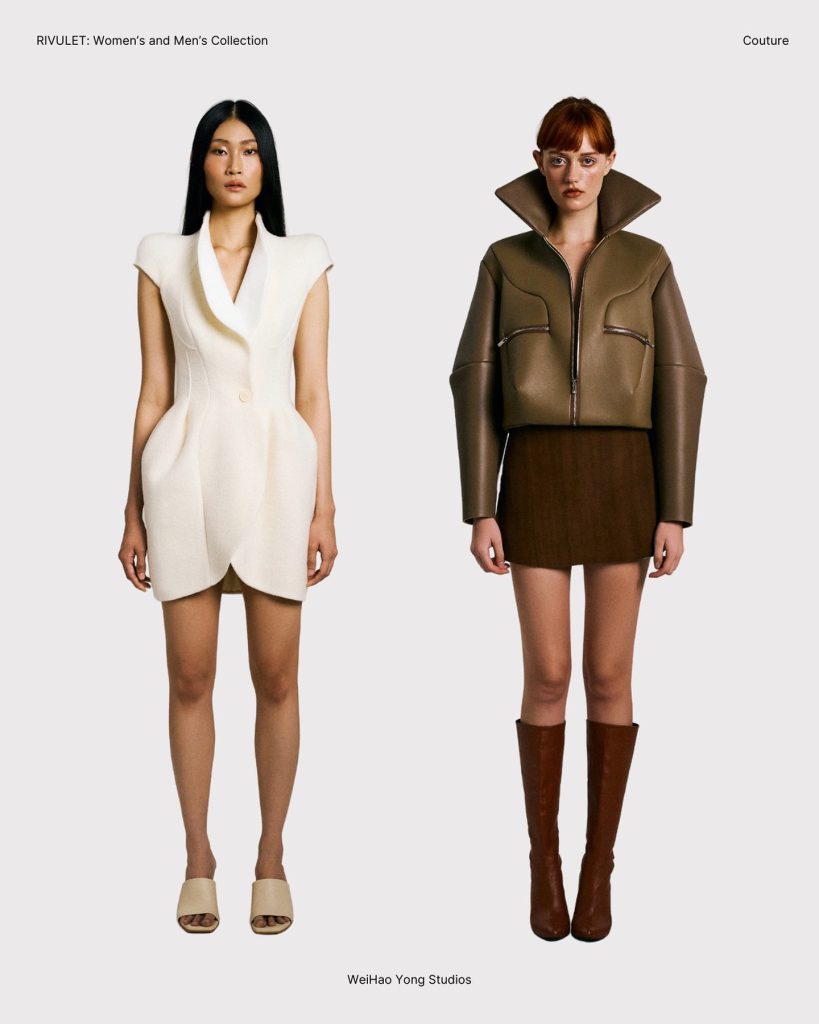
“Like a piece of art” is what came into our minds, looking at Aaron Yong’s pieces for his eponymous label, Weihaoyong, in real life or even through campaign images. What surprised us, however, was when the Sabah-born designer shared that a creative process, for him, “always starts with the technicality—mainly draping and pattern making.” In an age where fashion, as a form of art, has become trend-driven and relies on mere aesthetics, Aaron’s decision to cling to the technicality—or in other words, the abecedarian of the art—is a heart balm.
As a detail-oriented couture or made-to-measure designer, Aaron shared that all his creative expression boils down to, or rather, is rooted in the simple desire to make quality garments. “Over the years, I’ve realised that my clients’ preferences in fashion play a significant role in shaping my design approach, allowing me to evolve and adapt,” the designer explains. The label, despite carrying a strong sense of brand identity, was never an ivory tower but a shared community, one where creators and wearers crossed paths to create pieces that equilibrate between wearability and art.
Ahead, we spoke to Aaron on what fuels him as a designer—and a collector—along with his experiences as a local designer who hangs his hat on niceties in garment making.


Has fashion always been something you envisioned yourself doing? How did the eponymous brand come about?
I wouldn’t say fashion was always the plan, but I’ve always been drawn to construction and technique. My early interest in origami, my love for sculpting, and classical painting were likely the main influences. My path into fashion became clearer after receiving a scholarship prize that opened doors for me.
The label came to life after I gained experience working with various designers and participated in competitions to gain experience and build my portfolio. In 2017, I took a leap of faith, launched my brand and became a part of showrooms in Shanghai and Paris. The journey has had its challenges, and progress took time, but it’s been a valuable learning experience. Step by step, I’m getting there.
For a fashion brand that zeroes in on Dadaist art and mid-century modern architecture, what about these forms of art appeals to you? How do you incorporate them into building your brand identity?
Modern architecture embraces a sense of intentionality through subversion or structure. That duality resonates deeply with my design philosophy. Dadaism’s rejection of conventional aesthetics and embrace of spontaneity allow me to challenge traditional fashion norms—incorporating unexpected silhouettes, asymmetry, and a sense of irreverence in detailing. On the other hand, mid-century modern architecture’s emphasis on clean lines, functional beauty, and material integrity informs my approach to construction and minimalism.
I merged these influences by balancing deconstruction with precision in building my brand identity. My designs often juxtapose sharp tailoring with fluid draping, or stark monotones with tactile, layered textures. The result is a wardrobe that feels both intellectually engaging and effortlessly wearable—an interplay between rebellion and refinement.

As an avid fan of Phoebe Philo, how has the designer influenced your approach to fashion design?
Phoebe Philo has had a profound impact on me, not just as a designer but as a collector. For years, I’ve been deeply immersed in archiving and sourcing her runway pieces, long before preloved fashion became mainstream. I would scout rare finds through sample sales, The RealReal, eBay and Vestiaire Collective, eventually turning this passion into a business via my Instagram account, @philo_finds, where I curated and sourced pieces for clients.
Through collecting and studying her work, I developed a deep appreciation for the meticulous attention to detail she brings to design. It’s not just about the overall aesthetic but the subtle elements—the fine finishing, the construction, the fabrication, and even the hardware. Every aspect is intentional, never excessive, and always refined. That philosophy has directly influenced my work, as I apply the same principles of restraint, precision, and thoughtfulness to my label.
Is there a piece of yours, or anyone else’s work, that is precious to you?
The leather bomber jacket from my past collection is definitely a favourite of mine for now. But currently I’m obsessed with a white blazer by @editionofficial. The design idea might have taken inspiration from archival Martin Margiela, but the execution is flawless. It’s the perfect blend of complex techniques, juxtaposed with raw cut fabric fused seamlessly over a canvassed tailored jacket.

Doing couture, custom-made and also ready to wear, what are the biggest differences?
With couture or custom-made pieces, the focus is entirely on the client’s needs and preferences. Each piece is crafted with exact measurements, using the highest quality materials sourced from the top suppliers, which reflects in the higher price point. In contrast, ready-to-wear is designed for a broader audience, offering versatile pieces that seamlessly fit into everyday wardrobes while maintaining a balance between design and accessibility.
On that note, I’m excited to be relaunching my ready-to-wear line in June 2025, so stay tuned for more!
Tell us more about your “form follows function” ethos.
I’ve always believed that in design, form should follow function. Every detail should have a purpose and feel seamlessly integrated rather than merely decorative. For example, a pocket might be embedded within a cut line, or a lapel could flow effortlessly into the body without excess bulk, almost like a trompe l’oeil effect. Even constructing an entire garment with just a single seam while maintaining impeccable fit is a challenge I embrace. It’s about pushing the boundaries of construction while maintaining a sense of ease and refinement.

Of all the facets in this business, which takes the utmost priority?
The quality of the pieces I create and the wearer’s satisfaction are the utmost priorities. It’s not just about making clothes—it’s about building lasting relationships with my clients. I take the time to understand their tastes, needs, and lifestyles, and that connection translates directly into my design process.
There’s a mutual exchange of inspiration. I can confidently say that my clients shape the direction of my work just as much as I aim to shape their wardrobes. Their feedback, preferences, and individuality push me to evolve creatively and refine what I offer. At the heart of it all, I want every garment to feel both personal and purposeful.
This long-term collaboration with TALEE, how did that come about?
Our collaboration started through a mutual childhood friend from our hometown, Kota Kinabalu. I’ve always been fascinated by knots, and partnering with Talee Studio adds a unique touch to my drapes with intricate closures and hardware. Her work, made primarily from natural fibres, not only complements my designs beautifully but also ensures ease of care and maintenance.

As a young designer, what do you think is not talked about enough?
One of the most overlooked challenges for young designers is the pressure to align with unrealistic price points driven by fast fashion. This has significantly devalued the craft, often at the expense of quality and thoughtful construction.
I see bespoke garments as more than just clothing—they’re a form of art and a service, resulting in something tangible and deeply personal. Fashion should be held in the same regard as any other creative discipline—it demands just as much time, skill, and emotional labour. While aesthetics will always have their place, I believe longevity should hold equal weight. A well-designed garment should not only flatter the wearer and suit the occasion, but also be built to last and seamlessly fit into a thoughtful, versatile wardrobe.
What do you hope to bring to the table? What are your long-term goals?
In the local fashion scene, bespoke garments are often reserved for special occasions. I’d like to challenge that norm by creating space for everyday, custom-made pieces—timeless staples that are thoughtfully designed and truly worth the investment.
This vision ties closely to my broader goal: to reshape the way locally made fashion is perceived. I want to foster greater trust in homegrown craftsmanship and show that our work can confidently stand alongside global standards, both in quality and creativity.
Rather than chasing rapid growth or lofty ideals, my focus is on building a brand that is sustainable, intentional, and continuously evolving. Through my ready-to-wear line, I aim to offer elevated essentials, while my custom pieces add a more personal, intimate touch, helping clients build wardrobes that reflect their individuality with subtle sophistication.
READ MORE
Modernised Traditional Fashion in Malaysia: How Far is Too Far?
Jean Paul Gaultier Welcomes Duran Lantink as Creative Director
